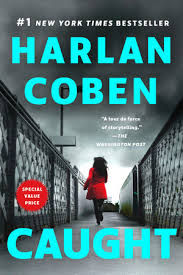Caught by Harlan Coben
- NZ Booklovers

- Jan 15, 2020
- 3 min read

Until a few years ago I was relatively unversed in the crime/thriller/mystery genre, aside from the sedate likes of Agatha Christie and P D James: the modern megasellers (James Patterson, Jonathan Kellerman et al) hovered in my peripheral vision in other domains of the bookshop.
It was Harlan Coben’s compelling 2007 novel The Woods that at last introduced me to the sophisticated modern thriller, in which the reader finds a plot with multiple connected sub-plots, crime depicted in grisly detail, unforeseeable twists, and hard-bitten characters who, despite their seen-it-all-before miens, are invariably shocked by the new chaos they encounter as they lurch toward an unpredictable climax and denouement.
A common feature of the postmodern thriller is the clever use of science and technology – Kathy Reichs, Val McDermid and Karin Slaughter are handy at this – and these days the protagonist is as likely to be a forensic pathologist or crime-scene investigator as a detective inspector.
In Coben’s 17th novel, Caught, he sticks to his knitting with a crackerjack story that makes a swift take-off. The scene is set with two parallel plotlines that initially don’t intersect – the disappearance of a 17-year-old high school student, and a sting operation by a tabloid reporter who tracks online sexual predators and exposes them in a national news programme.
In the opening chapter, the reporter, Wendy Tynes, follows social worker Dan Mercer to a house to which he has been summoned by a troubled teenage girl. She busts him, but the ‘exposure’ turns out to be less than definite – though there is little immediate evidence that Dan is in fact a child abuser, the repercussions for both Dan and Wendy are swift and calamitous.
Out of a job and still uncertain as to the truth about the social worker, Wendy finds her curiosity further piqued when Dan calls her, telling her he was set up and that they need to meet in person. He summons her to a trailer park in rural New Jersey where he has gone into hiding, and she finds him sporting mysterious bruises and a bad dye job. Before Wendy can learn more from Dan the plot thickens, as the father of another of Dan’s alleged victims storms the scene and takes what he believes to be revenge.
Coben uses this turn in the plot to pose the novel’s key questions: who are the real villains of the piece, what crimes have they committed, and has the missing girl, Haley McWaid, fallen victim to foul play or simply decided, on a teenage whim, to absent herself from ordinary life?
The latter query appears to be answered when the local sheriff’s scouring of Dan’s former motel room turns up Haley McWaid’s iPhone – with the plotted coordinates of a specific area of the local park. A connection between the two storylines has thus been established, and Coben ramps up the action with inspired digging by Wendy, who finds that Dan and his four college housemates have each experienced the destruction of their personal reputation in the past couple of years.
Dan’s avowal that he was a victim now seems justified – but who is targeting the men, and why?
To say more would be to spill the best beans of Caught, which doesn’t rewrite the rules of the crime thriller but more than meets the requirements of fans of the genre and this writer. Coben’s talent lies in pacing and structure – it is harder than it seems to dive between disparate narratives while engaging rather than confusing the reader – and in subtly guiding the reader’s interpretation of each character while withholding just enough crucial data to produce the requisite big bang. Very satisfying.
This review was previously published on Coast.co.nz.
Reviewer: Stephanie Jones
Penguin Random House



